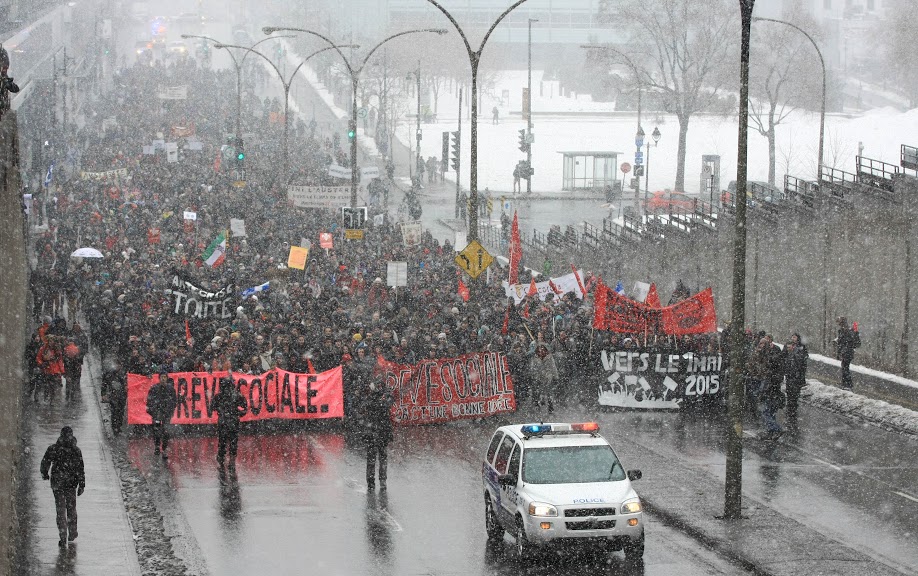Approximately 5,000 people marched through the streets of Montreal on March 21 in a demonstration against austerity and the oil industry. The demonstration kicked off a student strike, which will officially begin on March 23 for over fifty student associations representing almost 50,000 students province-wide. The protest began at Place Émilie-Gamelin and lasted for about two and a half hours.
The rally was the first event in a series of events against austerity organized by the Comité Printemps 2015. The “Spring Committee” works to unite and mobilize students and workers in the anti-austerity movement. The collective intends to hold weekly demonstrations against austerity on Saturdays, supported by the Association pour une solidarité syndicale étudiante (ASSÉ). Other future mobilizations include demonstrations throughout the week and a large-scale ASSÉ-organized protest on April 2 in Montreal.
Many students were present at the demonstration. “Over the last year and a half […] more classes are going online, and the education students are given is not what they are paying for,” Julie Chan, a law student at Université de Montréal, told The Daily.
As opposed to the student strikes in 2011-12, which directly targeted tuition raises, the anti-austerity movement today takes a much broader stance. Many student and worker groups and unions attended the march, protesting against cuts to public and social services, including the healthcare and education system.
“Even it’s not directly [affecting] you, it’s always someone near you.”
“My mom and her retirement plans are a bit set off because of the cuts,” Chan continued. “My grandmother has to drive to Montreal to get eye surgery. The bills for the bus used to be covered for her and now they’re not covered for her anymore.”
Many protesters held signs that read “Refusons l’austérité” (Let’s refuse austerity) at the rally, and some wore red squares, which were used as a symbol to oppose tuition hikes in 2012. Demonstrators united in anti-capitalist chants during the march.
“[The effect of austerity is] strong because you don’t feel it right away, it happens gradually,” Sarah Pelletier, a political science graduate student at Université du Québec à Montréal (UQAM), told The Daily. “I think that the main difference between 2011-12 and 2015 is [that] we don’t feel the effects right away, but we know that there’s all these cuts that are going to happen to education and the health system, and we know it will affect directly minorities and vulnerable populations.”
“Even it’s not directly [affecting] you, it’s always someone near you,” Pelletier noted. “It’s my friends that cannot send their child to a centre de la petite enfance (CPE) [daycare] and […] my sister who’s pregnant. […] It scares me to know that my nephew is not going to have what I used to have […] because it will be much more expensive for her to send her child to a CPE.”
“The government has cut funding from all the public services, so it’s important to come demonstrate and send a message,” one anonymous attendee stated in French.
Although the Montreal police tolerated the event, they did not consider this demonstration legal, since no itinerary for the march was provided. One protester was arrested for allegedly assaulting a police officer, three demonstrators were ticketed for allegedly violating a bylaw banning firecracker use, and another for violating bylaw P-6, which among other things bans wearing masks at protests.
[flickr id=”72157649179829883″]
